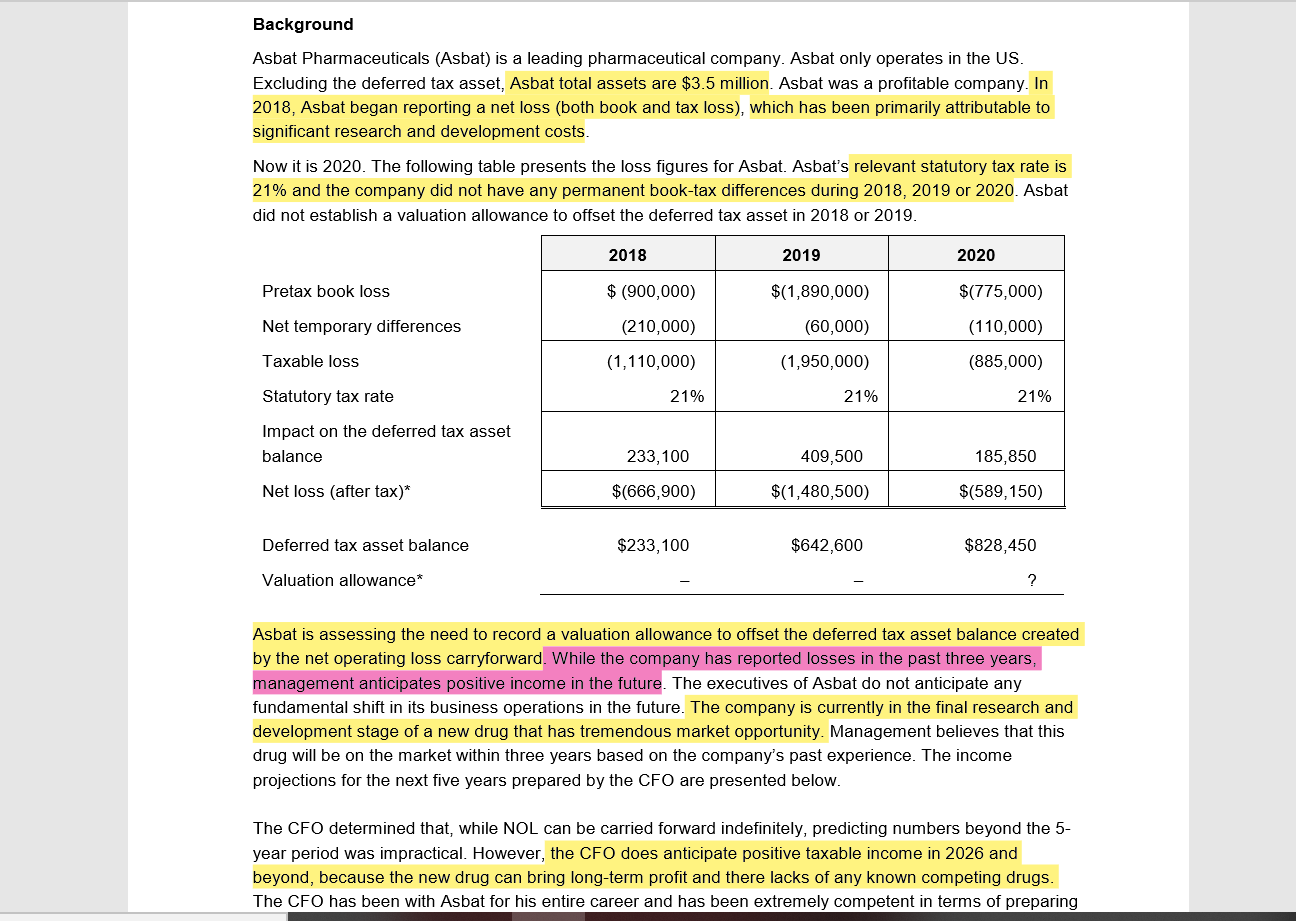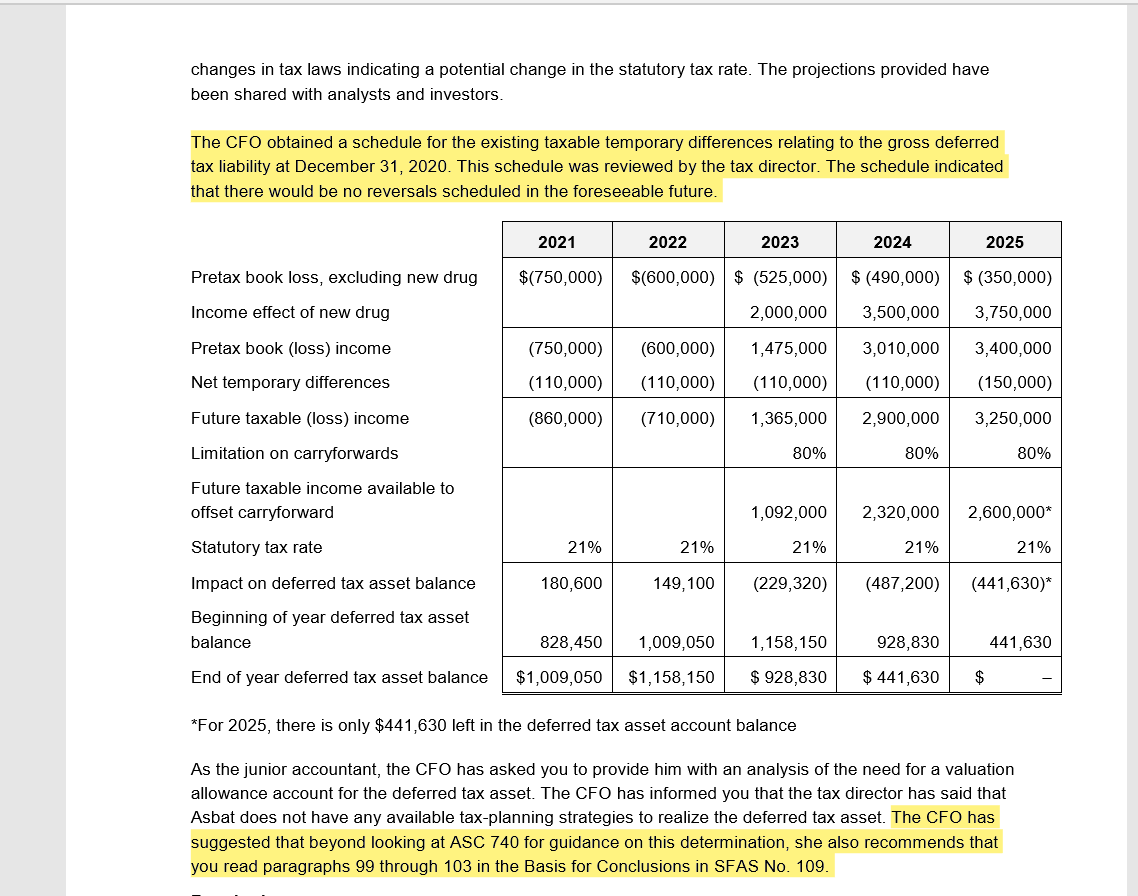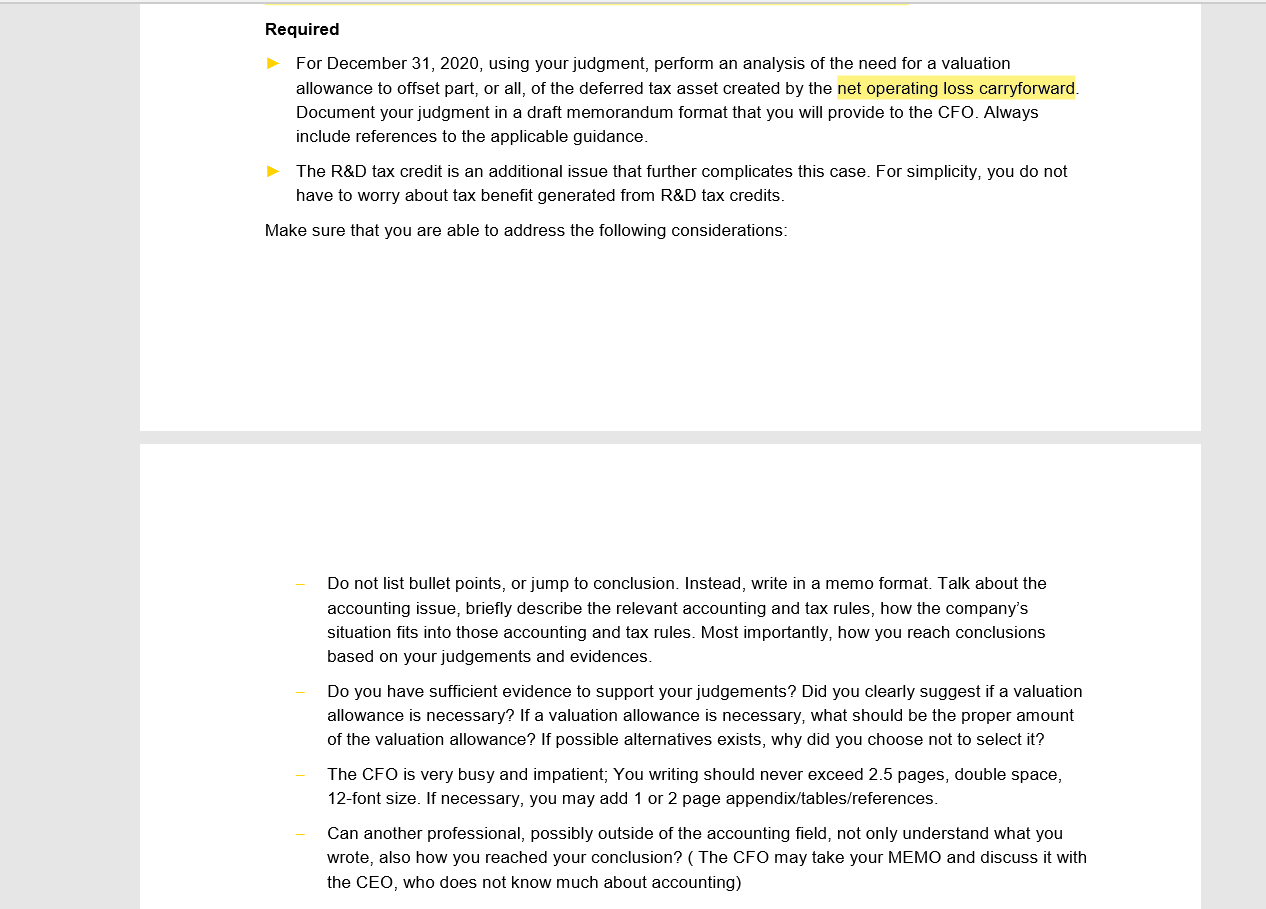Hello. I am struggling on a segment of this particular problem.
I already found the relevant ASC codes for my assignment nor do I need help writing the memo itself. However, I do need help finding the proper amount of valuation allowance along with the appropriate calculations, journal entries, etc. on how to arrive at that particular amount (I'm assuming that the company will need a valuation allowance account due to negative evidence).
Please provide your response in Word or Excel format as handwritten responses are hard to read. I would greatly appreciate it. Thank you.



Background Asbat Pharmaceuticals (Asbat) is a leading pharmaceutical company. Asbat only operates in the US. Excluding the deferred tax asset, Asbat total assets are $3.5 million. Asbat was a profitable company. In 2018, Asbat began reporting a net loss (both book and tax loss), which has been primarily attributable to significant research and development costs. Now it is 2020. The following table presents the loss figures for Asbat. Asbat's relevant statutory tax rate is 21% and the company did not have any permanent book-tax differences during 2018, 2019 or 2020. Asbat did not establish a valuation allowance to offset the deferred tax asset in 2018 or 2019. 2018 2019 2020 Pretax book loss $(1,890,000) $(775,000) Net temporary differences (60,000) $ (900,000) (210,000) (1,110,000) 21% (1,950,000) 21% (110,000) (885,000) 21% Taxable loss Statutory tax rate Impact on the deferred tax asset balance 233,100 409,500 185,850 Net loss (after tax)* $(666,900) $(1,480,500) $(589,150) Deferred tax asset balance $233,100 $642,600 $828,450 Valuation allowance* Asbat is assessing the need to record a valuation allowance to offset the deferred tax asset balance created by the net operating loss carryforward. While the company has reported losses in the past three years, management anticipates positive income in the future. The executives of Asbat do not anticipate any fundamental shift in its business operations in the future. The company is currently in the final research and development stage of a new drug that has tremendous market opportunity. Management believes that this drug will be on the market within three years based on the company's past experience. The income projections for the next five years prepared by the CFO are presented below. The CFO determined that, while NOL can be carried forward indefinitely, predicting numbers beyond the 5- year period was impractical. However, the CFO does anticipate positive taxable income in 2026 and beyond, because the new drug can bring long-term profit and there lacks of any known competing drugs. The CFO has been with Asbat for his entire career and has been extremely competent in terms of preparing changes in tax laws indicating a potential change in the statutory tax rate. The projections provided have been shared with analysts and investors. The CFO obtained a schedule for the existing taxable temporary differences relating to the gross deferred tax liability at December 31, 2020. This schedule was reviewed by the tax director. The schedule indicated that there would be no reversals scheduled in the foreseeable future. 2021 2022 2023 2024 2025 Pretax book loss, excluding new drug $(750,000) $ (490,000) 3,500,000 Income effect of new drug Pretax book (loss) income $(600,000) $ (525,000) 2,000,000 (600,000) 1,475,000 (110,000) (110,000) (710,000) 1,365,000 (750,000) (110,000) (860,000) 3,010,000 (110,000) $ (350,000) 3,750,000 3,400,000 (150,000) 3,250,000 80% Net temporary differences Future taxable (loss) income 2,900,000 80% Limitation on carryforwards 80% Future taxable income available to offset carryforward 1,092,000 2,320,000 2,600,000* Statutory tax rate 21% 21% 21% 21% 21% Impact on deferred tax asset balance 180,600 149,100 (229,320) (487,200) (441,630)* Beginning of year deferred tax asset balance 828,450 $1,009,050 1,009,050 $1,158,150 1,158,150 $ 928,830 928,830 $ 441,630 441,630 $ - | End of year deferred tax asset balance *For 2025, there is only $441,630 left in the deferred tax asset account balance As the junior accountant, the CFO has asked you to provide him with an analysis of the need for a valuation allowance account for the deferred tax asset. The CFO has informed you that the tax director has said that Asbat does not have any available tax-planning strategies to realize the deferred tax asset. The CFO has suggested that beyond looking at ASC 740 for guidance on this determination, she also recommends that you read paragraphs 99 through 103 in the Basis for Conclusions in SFAS No. 109. Required For December 31, 2020, using your judgment, perform an analysis of the need for a valuation allowance to offset part, or all, of the deferred tax asset created by the net operating loss carryforward Document your judgment in a draft memorandum format that you will provide to the CFO. Always include references to the applicable guidance. The R&D tax credit is an additional issue that further complicates this case. For simplicity, you do not have to worry about tax benefit generated from R&D tax credits. Make sure that you are able to address the following considerations: Do not list bullet points, or jump to conclusion. Instead, write in a memo format. Talk about the accounting issue, briefly describe the relevant accounting and tax rules, how the company's situation fits into those accounting and tax rules. Most importantly, how you reach conclusions based on your judgements and evidences. Do you have sufficient evidence to support your judgements? Did you clearly suggest if a valuation allowance is necessary? If a valuation allowance is necessary, what should be the proper amount of the valuation allowance? If possible alternatives exists, why did you choose not to select it? The CFO is very busy and impatient; You writing should never exceed 2.5 pages, double space, 12-font size. If necessary, you may add 1 or 2 page appendix/tables/references. Can another professional, possibly outside of the accounting field, not only understand what you wrote, also how you reached your conclusion? (The CFO may take your MEMO and discuss it with the CEO, who does not know much about accounting) Background Asbat Pharmaceuticals (Asbat) is a leading pharmaceutical company. Asbat only operates in the US. Excluding the deferred tax asset, Asbat total assets are $3.5 million. Asbat was a profitable company. In 2018, Asbat began reporting a net loss (both book and tax loss), which has been primarily attributable to significant research and development costs. Now it is 2020. The following table presents the loss figures for Asbat. Asbat's relevant statutory tax rate is 21% and the company did not have any permanent book-tax differences during 2018, 2019 or 2020. Asbat did not establish a valuation allowance to offset the deferred tax asset in 2018 or 2019. 2018 2019 2020 Pretax book loss $(1,890,000) $(775,000) Net temporary differences (60,000) $ (900,000) (210,000) (1,110,000) 21% (1,950,000) 21% (110,000) (885,000) 21% Taxable loss Statutory tax rate Impact on the deferred tax asset balance 233,100 409,500 185,850 Net loss (after tax)* $(666,900) $(1,480,500) $(589,150) Deferred tax asset balance $233,100 $642,600 $828,450 Valuation allowance* Asbat is assessing the need to record a valuation allowance to offset the deferred tax asset balance created by the net operating loss carryforward. While the company has reported losses in the past three years, management anticipates positive income in the future. The executives of Asbat do not anticipate any fundamental shift in its business operations in the future. The company is currently in the final research and development stage of a new drug that has tremendous market opportunity. Management believes that this drug will be on the market within three years based on the company's past experience. The income projections for the next five years prepared by the CFO are presented below. The CFO determined that, while NOL can be carried forward indefinitely, predicting numbers beyond the 5- year period was impractical. However, the CFO does anticipate positive taxable income in 2026 and beyond, because the new drug can bring long-term profit and there lacks of any known competing drugs. The CFO has been with Asbat for his entire career and has been extremely competent in terms of preparing changes in tax laws indicating a potential change in the statutory tax rate. The projections provided have been shared with analysts and investors. The CFO obtained a schedule for the existing taxable temporary differences relating to the gross deferred tax liability at December 31, 2020. This schedule was reviewed by the tax director. The schedule indicated that there would be no reversals scheduled in the foreseeable future. 2021 2022 2023 2024 2025 Pretax book loss, excluding new drug $(750,000) $ (490,000) 3,500,000 Income effect of new drug Pretax book (loss) income $(600,000) $ (525,000) 2,000,000 (600,000) 1,475,000 (110,000) (110,000) (710,000) 1,365,000 (750,000) (110,000) (860,000) 3,010,000 (110,000) $ (350,000) 3,750,000 3,400,000 (150,000) 3,250,000 80% Net temporary differences Future taxable (loss) income 2,900,000 80% Limitation on carryforwards 80% Future taxable income available to offset carryforward 1,092,000 2,320,000 2,600,000* Statutory tax rate 21% 21% 21% 21% 21% Impact on deferred tax asset balance 180,600 149,100 (229,320) (487,200) (441,630)* Beginning of year deferred tax asset balance 828,450 $1,009,050 1,009,050 $1,158,150 1,158,150 $ 928,830 928,830 $ 441,630 441,630 $ - | End of year deferred tax asset balance *For 2025, there is only $441,630 left in the deferred tax asset account balance As the junior accountant, the CFO has asked you to provide him with an analysis of the need for a valuation allowance account for the deferred tax asset. The CFO has informed you that the tax director has said that Asbat does not have any available tax-planning strategies to realize the deferred tax asset. The CFO has suggested that beyond looking at ASC 740 for guidance on this determination, she also recommends that you read paragraphs 99 through 103 in the Basis for Conclusions in SFAS No. 109. Required For December 31, 2020, using your judgment, perform an analysis of the need for a valuation allowance to offset part, or all, of the deferred tax asset created by the net operating loss carryforward Document your judgment in a draft memorandum format that you will provide to the CFO. Always include references to the applicable guidance. The R&D tax credit is an additional issue that further complicates this case. For simplicity, you do not have to worry about tax benefit generated from R&D tax credits. Make sure that you are able to address the following considerations: Do not list bullet points, or jump to conclusion. Instead, write in a memo format. Talk about the accounting issue, briefly describe the relevant accounting and tax rules, how the company's situation fits into those accounting and tax rules. Most importantly, how you reach conclusions based on your judgements and evidences. Do you have sufficient evidence to support your judgements? Did you clearly suggest if a valuation allowance is necessary? If a valuation allowance is necessary, what should be the proper amount of the valuation allowance? If possible alternatives exists, why did you choose not to select it? The CFO is very busy and impatient; You writing should never exceed 2.5 pages, double space, 12-font size. If necessary, you may add 1 or 2 page appendix/tables/references. Can another professional, possibly outside of the accounting field, not only understand what you wrote, also how you reached your conclusion? (The CFO may take your MEMO and discuss it with the CEO, who does not know much about accounting)









